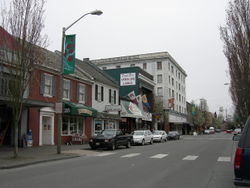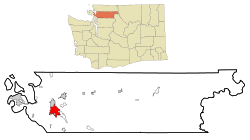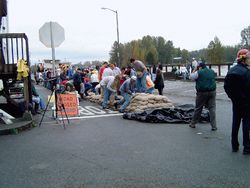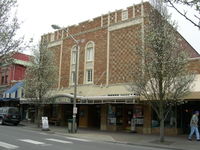Mount Vernon, Washington
| City of Mount Vernon | |
|---|---|
| — City — | |
 |
|
 |
|
| Coordinates: | |
| Country | United States |
| State | Washington |
| County | Skagit |
| Incorporated | July 5, 1889 |
| Government | |
| - Type | Mayor-council |
| - Mayor | Bud L. Norris |
| - City Attorney | Kevin Rogerson |
| Area[1] | |
| - Total | 11.4 sq mi (29.4 km2) |
| - Land | 11.1 sq mi (28.8 km2) |
| - Water | 0.3 sq mi (0.7 km2) 2.29% |
| Elevation | 180 ft (54.9 m) |
| Population (2000)[2] | |
| - Total | 26,232 |
| - Density | 2,360.6/sq mi (911.6/km2) |
| Time zone | PST (UTC-8) |
| - Summer (DST) | PDT (UTC-7) |
| ZIP codes | 98273, 98274 |
| Area code(s) | 360 |
| FIPS code | 53-47560[2] |
| GNIS feature ID | 1512485[3] |
| Website | www.ci.mount-vernon.wa.us |

Mount Vernon is a city in Skagit County, Washington, United States. The population was 26,232 at the 2000 census. It is one of two principal cities of and included in the Mount Vernon-Anacortes, Washington Metropolitan Statistical Area. It is the county seat of Skagit County. Downtown Mount Vernon is known for its annual Tulip Festival Street Fair which is part of the Skagit Valley Tulip Festival. The climate of Skagit County is similar to that of northern France. While millions of tulips are grown in the Skagit Valley, none are shipped to the European Union, which has strict import-export laws that protect its markets. In 1998, Mount Vernon was rated the #1 "Best Small City in America" by the New Rating Guide to Life in America's Small Cities.[4][5]
Contents |
History
Early days
Jasper Gates and Joseph Dwelley first settled on the banks of the Skagit River, where the city of Mount Vernon now lies, in 1870. Later on, Harrison Clothier came to the community in 1877 to teach school and join in business with a former student, E.G. English. They were later recognized as the city's founders and pioneer businessman. A post office was established in November 1877 with Clothier appointed postmaster. The city was named after Mount Vernon, the plantation estate and resting place of George Washington.[6] The two men laid out the city's first plat while the area was still heavily timbered.[7]
Mount Vernon's first industry were the logging camps set up to log the townsite. The community grew quickly following the loggers and hotels and saloons opened up along the Skagit River next to English & Clothiers' store. While poised to grow, river access to the community was stymied by a massive log jam in the river which prevented large ships to port. Mail carriers instead had to paddle canoes down-stream to nearby Skagit City. The mining activity at nearby Ruby Creek spurred growth for a short time in 1880, gaining the city a new hotel, but little else was accomplished when the mines proved to be shallow. More logging operations were established but were not profitable due to the low price of logs at the time. By 1881, Mount Vernon's permanent population was 75.[7]
Growth in the 1880s was steady. In 1882, the Odd Fellows Lodge was established, followed by the first newspaper in 1884, The Skagit News. The first church, Baptist, was also established in 1884 but wouldn't build a permanent building for several years. In November 1884, Mount Vernon's future was secured when it was chosen for the Skagit County seat. The Odd fellows building, built the following year, served the counties needs until a permanent building was built.[7]
The Railroad and growth into the 20th century
Mount Vernon's growth was helped by its central location in reference to the mining, logging and farming communities of the eastern and central parts of the county as well as its access to Puget Sound. The only thing it was lacking was a railroad connection to the outside world, especially, Everett, Seattle and Vancouver, B.C.. A committee was appointed in 1889 to negotiate with railroads on line placement. Their efforts paid off when the Great Northern Railway agreed to lay their line through the city. This was completed in 1891. The city was also in the process of convincing the Seattle, Lake Shore and Eastern Railway to come to Mt. Vernon. This deal fell through after the railroad was acquired by Northern Pacific Railway who chose to lay tracks further east through Sedro Woolley in 1896.[7]
The railroad's arrival caused great commotion in Mount Vernon, bringing hundreds of new businesses and residents. Mount Vernon was officially incorporated on July 5, 1893. That same year, a large brick courthouse was built on Main street, which still stands today. Due to the area's stable economy, Mount Vernon never boomed in the 1890s like many other speculative booms in the region. The city experienced its first of many fires in 1891 when several blocks along the waterfront were destroyed. The boost from the railroad's construction quickly replaced these buildings. 1891 also saw the construction of several large civic structures such as a large brick schoolhouse on the hill above the city as well as the Mount Vernon Opera House, designed by Peacock & Dalton.
Growth slowed considerably after the Panic of 1893. Following a large flood in 1894, the first Dyke was built along the Skagit River. Another great fire in 1900 wiped out all of Mount Vernon's original structures including English & Clothiers' store and the Ruby Hotel. Fire would destroy more downtown businesses in 1903. The city finally received a water system in 1902 after a failed attempt in 1894.[7]
Later events and transportation
The city again grew in the late 1910s when the Interurban railroad constructed its Everett to Bellingham line directly through downtown Mount Vernon. It was soon joined by the Pacific Highway which would eventually replace it. In 1969, Interstate 5 was built through downtown, severing it from most of the residential district and opening the farm lands north of the city to urban development where many of Mount Vernon's downtown businesses moved.
Notable local people, living and dead
- Glenn Beck, host of Glenn Beck on Fox News channel.
- Cheryl Bentyne, jazz singer and member of The Manhattan Transfer
- Jim Caviezel, actor; most well-known for his role as Jesus in The Passion of the Christ.
- Scott Clements, Professional Poker Player.
- Mark Hendrickson, Major League Baseball player and former NBA basketball player.
- Craig Kelly, pioneer snowboarder; killed by an avalanche in 2003.
- Kyle Kendrick, Major League Baseball, Starting Pitcher for the Philadelphia Phillies.
- Graham Kerr, culinary expert, author and television personality.
- Chad Lindberg, actor.
- Ross Mathews, Hello Ross.com and guest appearances on the Chelsea Lately show On E!
- T. J. Oshie, ice hockey player for the St. Louis Blues (NHL).
- Michael E. Pegram, the owner of the 1998 Kentucky Derby and Preakness Stakes winner Real Quiet.
- R. Garcia y Robertson, fantasy and science fiction writer.
- Coady Willis, drummer for Melvins, Big Business and Murder City Devils.
Notable buildings

The Historic Lincoln Theatre on First Street in downtown Mount Vernon was originally built in 1926 as a vaudeville and silent movie house. Through the early 1980s, the Lincoln was a movie theater showing first-run films and now hosts live theatrical performances and concerts while also showcasing classic, as well as contemporary, movies year-round. The Lincoln is one of only 98 theaters in the United States that still possesses its original Wurlitzer theatre organ, which is often played prior to a show.[8]
Flood control and waterfront redevelopment
Since this city was founded, the downtown area of Mount Vernon bordering the Skagit River has been plagued by flooding, especially during times of heavy rain. Each time the water rises above a certain level, citizens must join to build a sandbag wall that stretches six city blocks and can be as high as five feet tall. In the spring of 2007, the city council authorized the mayor to purchase a mobile flood wall from Norway-based company AquaFence, the first such flood wall sold in the United States.[9] The flood wall is four feet high and can be assembled in as little as three hours by a handful of volunteers as opposed to the up to 12 hours and hundreds of volunteers required by the traditional sandbag wall. The flood wall is meant to be a temporary solution while the city explores ways to build a permanent flood wall to remove the downtown area from the Federal Emergency Management Agency's 100-year flood plain maps.
After adequate flood control is in place, the Citizen’s Advisory Committee will begin to implement plans to enhance the city's use of the waterfront, which is currently used mostly for parking. Current plans call for a promenade with condos or mixed-use development facing the river.
Transportation
The new Skagit Station, built in 2004, delivers true multimodal transportation to a rapidly growing region.[10] Commuters and travelers can switch between modes of transportation in downtown Mount Vernon. The station offers stops for the Skagit Transit bus[11], Greyhound bus, Amtrak Cascades rail and local taxi. The new Everett Express bus route connects to the Sounder Train in Everett.[12]
Skagit Regional Airport, five miles (8 km) northwest, fills much of the area's general aviation needs. The closest commercial airport with scheduled passenger service is Bellingham International Airport, 25 miles (40 km) north.
Major highways
 Interstate 5 runs north-south from the Mexican Border to the Peace Arch at the United States-Canada border, at Blaine, Washington and to the Surrey, British Columbia border-crossing. It connects Mount Vernon to Seattle, Portland, Eugene, Redding, Sacramento, Los Angeles and San Diego.
Interstate 5 runs north-south from the Mexican Border to the Peace Arch at the United States-Canada border, at Blaine, Washington and to the Surrey, British Columbia border-crossing. It connects Mount Vernon to Seattle, Portland, Eugene, Redding, Sacramento, Los Angeles and San Diego. State Route 9 runs parallel to Interstate 5, linking Mount Vernon with Snohomish and Arlington to the south and Sedro-Woolley and the United States-Canada border near Sumas to the north.
State Route 9 runs parallel to Interstate 5, linking Mount Vernon with Snohomish and Arlington to the south and Sedro-Woolley and the United States-Canada border near Sumas to the north. State Route 20 runs east-west from U.S. Route 101 on the Olympic Peninsula to Washington-Idaho State Line at Newport, Washington. State Route 20 crosses Admiralty Inlet via the Port Townsend-Keystone ferry and passes just northwest of the city. The highway is known as the North Cascades Highway because it passes through the Northern Cascade Mountains and North Cascades National Park.
State Route 20 runs east-west from U.S. Route 101 on the Olympic Peninsula to Washington-Idaho State Line at Newport, Washington. State Route 20 crosses Admiralty Inlet via the Port Townsend-Keystone ferry and passes just northwest of the city. The highway is known as the North Cascades Highway because it passes through the Northern Cascade Mountains and North Cascades National Park. State Route 536 runs from SR 20 into downtown Mount Vernon and Interstate 5.
State Route 536 runs from SR 20 into downtown Mount Vernon and Interstate 5. State Route 538 runs east-west from Interstate 5 to SR 9 at the Baker Heights neighborhood of Mount Vernon.
State Route 538 runs east-west from Interstate 5 to SR 9 at the Baker Heights neighborhood of Mount Vernon.
Demographics
| Historical populations | |||
|---|---|---|---|
| Census | Pop. | %± | |
| 1900 | 1,120 |
|
|
| 1910 | 2,381 | 112.6% | |
| 1920 | 3,341 | 40.3% | |
| 1930 | 3,690 | 10.4% | |
| 1940 | 4,278 | 15.9% | |
| 1950 | 5,230 | 22.3% | |
| 1960 | 7,921 | 51.5% | |
| 1970 | 8,804 | 11.1% | |
| 1980 | 13,009 | 47.8% | |
| 1990 | 17,647 | 35.7% | |
| 2000 | 26,232 | 48.6% | |
| Est. 2008 | 31,513 | 20.1% | |
As of the census[2] of 2000, there were 26,232 people, 9,276 households, and 6,205 families residing in the city. The population density was 2,360.6 people per square mile (911.6/km²). There were 9,686 housing units at an average density of 871.6/sq mi (336.6/km²). The racial makeup of the city was 75.44% White, 0.73% African American, 1.02% Native American, 2.58% Asian, 0.15% Pacific Islander, 17.13% from other races, and 2.95% from two or more races. Hispanic or Latino of any race were 25.12% of the population.
There were 9,276 households out of which 36.5% had children under the age of 18 living with them, 51.3% were married couples living together, 11.4% had a female householder with no husband present, and 33.1% were non-families. 26.1% of all households were made up of individuals and 10.9% had someone living alone who was 65 years of age or older. The average household size was 2.75 and the average family size was 3.32.
In the city the population was spread out with 29.0% under the age of 18, 11.9% from 18 to 24, 29.0% from 25 to 44, 17.6% from 45 to 64, and 12.5% who were 65 years of age or older. The median age was 31 years. For every 100 females there were 96.2 males. For every 100 females age 18 and over, there were 92.9 males.
The median income for a household in the city was $53,496.[13] Males had a median income of $33,724 versus $27,244 for females. The per capita income for the city was $17,041. About 10.8% of families and 15.9% of the population were below the poverty line, including 18.9% of those under age 18 and 7.1% of those age 65 or over.
Sister cities
Mount Vernon has the following Sister Cities, according to the Washington State Lt. Governor's list of Washington Sister Cities:
Gallery
 Law Firm and water tower |
 Skagit River and the West Division Street bridge |
 Lincoln Theater (built 1926) |
 The Mount Vernon Café & Lounge |
 South First Street |
 Downtown as seen from west side of Skagit River with view of Mt. Baker |
 Skagit County Courthouse |
_High_School_-_Old_Main_02.jpg) Mount Vernon High School - Old Main |
See also
- Skagit City
References
- ↑ "US Gazetteer files: 2000 and 1990". United States Census Bureau. 2005-05-03. http://www.census.gov/geo/www/gazetteer/gazette.html. Retrieved 2008-01-31.
- ↑ 2.0 2.1 2.2 "American FactFinder". United States Census Bureau. http://factfinder.census.gov. Retrieved 2008-01-31.
- ↑ "US Board on Geographic Names". United States Geological Survey. 2007-10-25. http://geonames.usgs.gov. Retrieved 2008-01-31.
- ↑ "New Rating Guide to Life in America's Small Cities". http://www.amazon.com/Rating-Guide-Americas-Small-Cities/dp/0879755997.
- ↑ "Mount Vernon Live". http://www.livemountvernon.com/.
- ↑ Phillips, James W. (1971). Washington State Place Names. University of Washington Press. ISBN 0-295-95158-3.
- ↑ 7.0 7.1 7.2 7.3 7.4 An Illustrated history of Skagit and Snohomish Counties : their people, their commerce and their resources : with an outline of the early history of the state of Washington. Chicago, IL: Intersgtate Publishing Company, 1906. Print.
- ↑ Historical Information
- ↑ "AquaFence Website". http://www.aquafence.com/index.asp.
- ↑ "Skagit Station offers hope for renewal". http://www.djc.com/news/co/11161148.html.
- ↑ "SKAT routes". http://www.skagittransit.org/index.cfm?do=page&pageID=1373.
- ↑ "SKAT Everett Express". http://skat.baron-co.com/index.cfm?pageID=3223.
- ↑ http://www.mountvernonchamber.com/members/business_resources/business_stats/
External links
|
||||||||||||||||||||
|
||||||||||||||||||||
|
||||||||||||||
